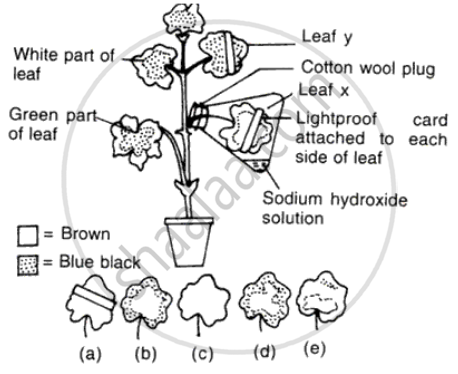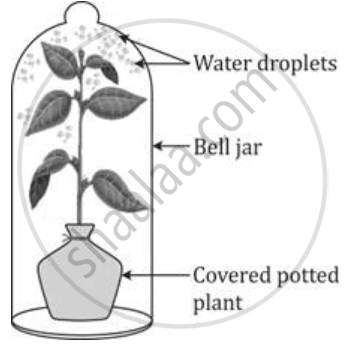Advertisements
Advertisements
Question
A well watered healthy potted plant with variegated leaves was kept in darkness for about 24 hours. It was then set up as shown in the diagram and exposed to light for about 12 hours. At the end of this time, leaf x and y were tested for starch. Study the diagram and answer the questions that follow:
(i) Why was the plant initially kept in darkness for 24 hours?
(ii) What is the function of sodium hydroxide solution in the flask?
(iii) Select the correct leaf from the five available choices shown in the diagram as a, b, c, d and e. Rewrite the correct answer by filling in the appropriate letter for the questions that follow:
1. After the starch test, leaf x would look like ______.
2. After the starch test, leaf y would look like ______.
(iv) The experiment with leaf y shows that photosynthesis requires the presence of certain factors. Mention any one factor.

Solution
(i) The plant was kept in the dark to destarch the leaves.
(ii) Sodium hydroxide absorbs CO2 thereby making the flask CO2 free.
(iii) (1) C, (2) E
(iv) Sunlight
APPEARS IN
RELATED QUESTIONS
An apparatus, as shown below, was set up to investigate a physiological process in plants. The setup was kept in sunlight for two hours. Droplets of water were then seen inside the bell jar. Answer the questions that follow:

- Name the process being studied.
- Explain the process named above in Q.3(a)(i).
- Why was the pot covered with a plastic sheet?
- Suggest a suitable control for this experiment.
- Mention two ways in which this process is beneficial to plants.
- List three adaptations in plants to reduce the above mentioned process.
Choose the correct answer:
The percentage of cuticular transpiration in plants is _____________
An apparatus as shown below was set up to investigate a physiological process in plants. The setup was kept in sunlight for two hours. Droplets of water were then seen inside the bell jar. Answer the questions that follow:

Suggest a suitable control for this experiment.
What are stomata? What governs the opening and closing of stomata?
______ involves evaporative loss of water from aerial parts.
Boojho’s uncle was hospitalised and put on dialysis after a severe infection in both of his kidneys.
What is dialysis?
Why is transpiration called a necessary evil?
Do different species of plants growing in the same area show the same rate of transpiration at a particular time? Justify your answer.
Briefly describe the following:
Angina Pectoris
Name the structures through which Transpiration occur in a plant.
